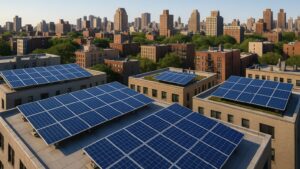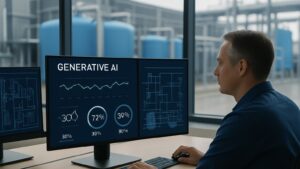Data centers are facing increasing challenges in maintaining a consistent and effective power supply. The reason stands to be the growing demand for processing power and data storage. Conventional grid-based power sources frequently experience fluctuations and interruptions. So, this results in expensive downtime and data loss. So, numerous data center operators have been motivated to investigate the deployment of data center microgrids.
These are localized energy systems capable of functioning autonomously from the main grid. However, selecting a fuel source for these microgrids is an important issue. It has a big influence on dependability, operational expenses as well as environmental impact. In this article, we will look at the fuel options for data center micrograms and how to choose them.
Understanding data center microgrids Fuel Sources
Many fuel sources can power data center microgrids. However, each fuel source has its pros and cons. This is in terms of availability, emissions, cost, and compatibility with energy storage devices. So, let’s see each of them:
Natural Gas as a Fuel Source
Natural gas has long been a preferred option for fuel when it comes to data center microgrids due to its availability and low emissions in comparison to other fossil fuels. Furthermore, it can provide both electrical and thermal energy. This is when it is in combination with heat and power systems. As a result, it improves total energy efficiency.
The emissions from the gas are lower than diesel or coal however it is still non-renewable and a fossil fuel. Additionally, it can prove to throw challenges due to supply outages and price volatility. It is also not as scalable as renewable sources.
Renewable Energy Sources: Solar and Wind
Renewable energy sources have recently drawn popularity. Some of the most chosen ones include wind and solar PV. They help lower the carbon footprint of data centers. Moreover, these environmentally friendly solutions support business sustainability objectives. Also, it may eventually save operating expenses.
Wind power may be a scalable and flexible option, depending on the location and wind patterns. Furthermore, solar PV systems provide the benefit of on-site generation and integration with energy storage. To guarantee a consistent power supply, backup systems or the incorporation of energy storage may be necessary. This is because both solar and wind energy are susceptible to sporadic and weather-dependent generation.
Biogas and Hydrogen: Emerging Fuel Sources for Microgrids
Two emerging fuel alternatives for data center microgrids include hydrogen, noted for its clean combustion, and biogas, derived from organic waste materials. These solutions provide low-emission and renewable alternatives. However, they also bring special infrastructural and technological maturity difficulties.
Waste management systems can produce biogas on-site. So, it offers a fuel source that is renewable and has comparatively low emissions. However, its supply would be restricted and there might be problems with odor and air quality to deal with.
On the other side, hydrogen has a high energy density and is very versatile. This is because it is still a young technology that requires expensive upfront infrastructure.
Integrating Energy Storage Systems
Energy storage system integration is essential for a dependable and continuous power supply in data center microgrids. This is regardless of the primary fuel source selected. Among the several kinds of energy storage technologies are thermal energy storage, flow batteries, and lithium-ion batteries. These technological advancements can help reduce the unpredictability of renewable energy sources. They can also offer backup power during blackouts or periods of high demand.
Energy storage systems enhance load balancing and peak demand control. As a result, it allows the storage of excess energy from renewable sources. Moreover, it increases energy resilience and dependability. They do, however, have higher upfront expenses, maintenance needs, and possible cycle life and discharge length constraints.
Fuel Sources For Data Center Microgrids: Case Studies
In this section, we will look at a few case studies of companies opting for fuel sources for data center microgrids and how it has benefited them:
Equinix data center microgrids with Fuel Cells
Fuel cells are the main power source in the microgrid system of Equinix. It is a well-known worldwide supplier of data centers, installed at its Silicon Valley facility. Natural gas is the fuel source for the fuel cells. It generates energy dependably and effectively with a lot less emissions than conventional generators.
In addition, the microgrid incorporates solar PV panels and battery energy storage devices. As a result, it allows the facility to run off the grid for extended periods. This hybrid strategy offers a scalable option for future development. It also ensures energy resiliency and lowers the data center’s carbon impact.
Google Data Center Powered by Wind and Solar
Google is known as a pioneer in the field of environmentally friendly data center management. The business has set up many renewable energy-powered data centers. One noteworthy example is their data center, which runs entirely on solar and wind power and is in Oklahoma’s Mayes County.
Onsite wind turbines and solar photovoltaic (PV) arrays are components of this plant. Sophisticated energy management software and cutting-edge energy storage technology round these out. By using this method, Google guarantees a steady and dependable power supply for its data center operations.
Data Center Microgrids: Best Practices for Fuel Source Selection
Based on industry experiences and lessons learned, several best practices have emerged for selecting the ideal fuel source for data center microgrids:
- Conduct a comprehensive energy assessment: To choose the best energy mix, examine the energy consumption trends. Also, see the anticipated future development and unique operating needs of your data center.
- Prioritize sustainability and emissions reduction: Make sure the fuel source you choose supports your company’s environmental impact. It should also support your greenhouse gas emission reduction goals.
- Consider long-term costs and savings: Consider the possibility of long-term operating cost reductions and the avoidance of future carbon pricing or emissions fines. Even when renewable energy sources have higher upfront costs, one should consider them.
- Plan for scalability and future growth: Make sure the microgrid system and fuel source you choose can be readily expanded. It should also be easily modified. This helps to meet the changing power needs of your data center as well as the incorporation of new technology.
- Engage with stakeholders and communities: Incorporate pertinent parties. It includes local governments, regulatory agencies, and energy suppliers, in the decision-making process. It helps to resolve any possible issues and promote cooperation
- Continuously monitor and optimize performance: Establish reliable analytics and monitoring tools. It helps to keep tabs on the fuel sources for microgrids and their performance. This will allow for ongoing optimization and necessary adjustments.
Conclusion
The significance of sustainable data center operations cannot be emphasized as the digital world keeps growing. The industry may achieve energy efficiency and environmental responsibility by using data center microgrids and making educated judgments regarding fuel sources.
The forthcoming Energy Efficiency for Data Centers Summit, which will take place in Dallas TX, USA on May 16–17, 2024, provides a fantastic chance to learn more about these subjects. It also provides a platform to network with business leaders and remain up to date on developments in environmentally friendly data center operations. Moreover, organizations may ensure a more robust and environmentally friendly digital infrastructure in the future by attending such events and making use of the shared expertise.





